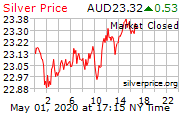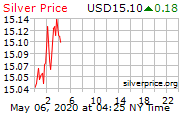Bob Farrell's 10 Rules for Investing
Page 1 of 1
 Bob Farrell's 10 Rules for Investing
Bob Farrell's 10 Rules for Investing
Wall Street “gurus” come and go, but in the case of Bob Farrell
legendary status was achieved. He spent several decades as chief stock
market analyst at Merrill Lynch & Co. and had a front-row seat at
the go-go markets of the late 1960s, mid-1980s and late 1990s, the
brutal bear market of 1973-74, and October 1987 crash.
Farrell retired in 1992, but his famous “10 Market Rules to Remember” have lived on and are summarized below, courtesy of The Big Picture and MarketWatch
(June 2008). The words of wisdom are timeless and are especially
appropriate as investors grapple with the difficult juncture at which
stock markets find themselves at this stage.
1. Markets tend to return to the mean over time
When stocks go too far in one direction, they come back. Euphoria and
pessimism can cloud people’s heads. It’s easy to get caught up in the
heat of the moment and lose perspective.
2. Excesses in one direction will lead to an excess in the opposite direction
Think of the market baseline as attached to a rubber string. Any action
too far in one direction not only brings you back to the baseline, but
leads to an overshoot in the opposite direction.
3. There are no new eras – excesses are never permanent
Whatever the latest hot sector is, it eventually overheats, mean reverts, and then overshoots.As
the fever builds, a chorus of “this time it’s different” will be
heard, even if those exact words are never used. And of course, it –
human nature – is never different.
4. Exponential rapidly rising or falling markets usually go further than you think, but they do not correct by going sideways
Regardless of how hot a sector is, don’t expect a plateau to work off
the excesses. Profits are locked in by selling, and that invariably
leads to a significant correction eventually.
5. The public buys the most at the top and the least at the bottom
That’s why contrarian-minded investors can make good money if they
follow the sentiment indicators and have good timing. Watch Investors
Intelligence (measuring the mood of more than 100 investment newsletter
writers) and the American Association of Individual Investors Survey.
6. Fear and greed are stronger than long-term resolve
Investors can be their own worst enemy, particularly when emotions take
hold. Gains “make us exuberant; they enhance well-being and promote
optimism”, says Santa Clara University finance professor Meir Statman.
His studies of investor behavior show that “Losses bring sadness,
disgust, fear, regret. Fear increases the sense of risk and some react
by shunning stocks.”
7. Markets are strongest when they are broad and weakest when they narrow to a handful of blue-chip names
This is why breadth and volume are so important. Think of it as
strength in numbers. Broad momentum is hard to stop, Farrell observes.
Watch for when momentum channels into a small number of stocks.
8. Bear markets have three stages – sharp down, reflexive rebound and a drawn-out fundamental downtrend
9. When all the experts and forecasts agree – something else is going to happen
As Sam Stovall, the S&P investment strategist, puts it: “If
everybody’s optimistic, who is left to buy? If everybody’s pessimistic,
who’s left to sell?Going against the herd as Farrell
repeatedly suggests can be very profitable, especially for patient
buyers who raise cash from frothy markets and reinvest it when
sentiment is darkest.
10. Bull markets are more fun than bear markets
Especially if you are long only or mandated to be fully invested. Those
with more flexible charters might squeak out a smile or two here and
there.
legendary status was achieved. He spent several decades as chief stock
market analyst at Merrill Lynch & Co. and had a front-row seat at
the go-go markets of the late 1960s, mid-1980s and late 1990s, the
brutal bear market of 1973-74, and October 1987 crash.
Farrell retired in 1992, but his famous “10 Market Rules to Remember” have lived on and are summarized below, courtesy of The Big Picture and MarketWatch
(June 2008). The words of wisdom are timeless and are especially
appropriate as investors grapple with the difficult juncture at which
stock markets find themselves at this stage.
1. Markets tend to return to the mean over time
When stocks go too far in one direction, they come back. Euphoria and
pessimism can cloud people’s heads. It’s easy to get caught up in the
heat of the moment and lose perspective.
2. Excesses in one direction will lead to an excess in the opposite direction
Think of the market baseline as attached to a rubber string. Any action
too far in one direction not only brings you back to the baseline, but
leads to an overshoot in the opposite direction.
3. There are no new eras – excesses are never permanent
Whatever the latest hot sector is, it eventually overheats, mean reverts, and then overshoots.As
the fever builds, a chorus of “this time it’s different” will be
heard, even if those exact words are never used. And of course, it –
human nature – is never different.
4. Exponential rapidly rising or falling markets usually go further than you think, but they do not correct by going sideways
Regardless of how hot a sector is, don’t expect a plateau to work off
the excesses. Profits are locked in by selling, and that invariably
leads to a significant correction eventually.
5. The public buys the most at the top and the least at the bottom
That’s why contrarian-minded investors can make good money if they
follow the sentiment indicators and have good timing. Watch Investors
Intelligence (measuring the mood of more than 100 investment newsletter
writers) and the American Association of Individual Investors Survey.
6. Fear and greed are stronger than long-term resolve
Investors can be their own worst enemy, particularly when emotions take
hold. Gains “make us exuberant; they enhance well-being and promote
optimism”, says Santa Clara University finance professor Meir Statman.
His studies of investor behavior show that “Losses bring sadness,
disgust, fear, regret. Fear increases the sense of risk and some react
by shunning stocks.”
7. Markets are strongest when they are broad and weakest when they narrow to a handful of blue-chip names
This is why breadth and volume are so important. Think of it as
strength in numbers. Broad momentum is hard to stop, Farrell observes.
Watch for when momentum channels into a small number of stocks.
8. Bear markets have three stages – sharp down, reflexive rebound and a drawn-out fundamental downtrend
9. When all the experts and forecasts agree – something else is going to happen
As Sam Stovall, the S&P investment strategist, puts it: “If
everybody’s optimistic, who is left to buy? If everybody’s pessimistic,
who’s left to sell?Going against the herd as Farrell
repeatedly suggests can be very profitable, especially for patient
buyers who raise cash from frothy markets and reinvest it when
sentiment is darkest.
10. Bull markets are more fun than bear markets
Especially if you are long only or mandated to be fully invested. Those
with more flexible charters might squeak out a smile or two here and
there.
Page 1 of 1
Permissions in this forum:
You cannot reply to topics in this forum|
|
|





 Home
Home




» going over old times
» Hi I'm Blythe and new to this site
» Hi-Jacked Thread
» Never say die.
» Peace and quiet.
» Christmas cheer
» we lost the mayor race
» Dear Diary